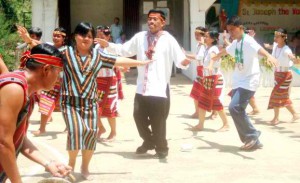By ARTHA KIRA PAREDES

WHILE thousands of barangays all over the country still await the final results of the Oct. 25 polls, eight of 10 barangays in Tubo town in Abra already knew their new set of officials about a month before election day.
This was made possible through the centuries-old dap-ay indigenous practice where community elders in Tubo, called the panglakayen, chose the winners in the race for village chiefs andcouncilors in barangays Alangtin, Dilong, Kili, Poblacion, Supo, Tiempo, Tubtuba and Tabacda as early as September.
Tubo, the second biggest land area among the 27 towns of Abra, is among the upland towns. It has two indigenous groups–the Maengs and the Belwangs.
“The dap-ay is a form of governance implemented by the father of our forefathers since the 16th century,” Tubo Mayor Wilma Gattud said.
The dap-ay practice in Tubo originated in nearby Mountain Province where its residents came from, according to Abra Provincial Planning and Development Officer Philip Tingonong.
Based on this practice, Gattud said the community elders called for a general assembly before the Oct.25 elections and asked attendees who among them were planning to run as barangay officials.
She said the elders selected only one barangay captain and the required number of councilors, using their own set of qualifications. Among the qualifications are regular attendance in community meetings and community service rendered.
Gattud said only the candidates selected by the elders filed their certificates of candidacy so they ran unopposed and became sure winners.
She said dap-ay was also used to determine their candidates in this year’s May presidential elections.
The elders make use of the dap-ay system to ensure peaceful elections because it discourages vote-buying, among other things, Gattud said. Dap-ay yields not only zero campaign-related expenses but also prevents violence, she added.
Abra, located some 400 kilometers north of Manila, is known to be a province whose leaders resort to terrorism and vote-buying to win elections. The province was among the “areas of concerns” declared by the Commission of Elections in the 2010 barangay elections.
Vote-buying in the capital town Bangued is said have gone not less than a million pesos per barangay, or P3,000 to P4,000 per person. Although several checkpoints were installed and police were very visible to ensure the orderly conduct of elections, incidents of shooting and squabbles among politicians in voting precincts were still reported.
Bangued was also placed under COMELEC control because of the reported presence of private armed groups and loose firearms that had fuelled tension among political candidates and their followers.
While incidents of shooting and political harassment through intimidation have been reported in other Abra towns, no similar reports appear in recent police records in Tubo.
In 2001, however, then incumbent Mayor Jose Segundo was killed. He is one of the three mayors killed since then. The other two were Tineg Mayor Clarence Benwaren in 2002 and La Paz Mayor Marc Ysrael Bernos in 2006.
Dap-ay may have been known for its political impact in Tubo because of its role in selecting candidates before the elections. But that is not its only role.
The Ancestral Domain Sustainable Development Protection Plan 2004-2014 of Tubo also lists policy and development planning as among the dap-ay’s roles and functions.
The 10-year plan defines dap-ay as a “system of governance by the Maeng Tribe, which manage(s) and direct(s) socioeconomic, cultural and spiritual life of the people in an ili (community).”
It further states, “The collective leadership of the elders is the master of all decisionmaking and the people exercise check and balance during tipon (assembly).”
According to the plan, “every ili has its own dap-ay (autonomous government) operating independently responsible for the management and development of the community concern.”
Abra is inhabited by Ilocanos and Tingguians–or people of the mountains, which Tingonong said is the “generic term Spaniards used in the late 1500s to refer to the different indigenous groups of Abra.”
He said the word is from the Malay term tinggi that means “mountain.” Although Abrenians are predominantly Ilocanos, there are 10 major Tingguian indigenous peoples in the province.
Abra is one of the six provinces of the Cordillera Administrative Region with a population of 230,953. Of this number, the Provincial Planning and Development Office estimates 34 to 35 percent to be Tingguian.
The province has 303 of the 41,995 barangays nationwide based on the 2006 tally of the National Statistics and Coordination Board tally.
